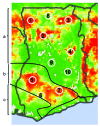Two novel arenaviruses detected in pygmy mice, Ghana
- PMID: 24188212
- PMCID: PMC3837667
- DOI: 10.3201/eid1911.121491
Two novel arenaviruses detected in pygmy mice, Ghana
Abstract
Two arenaviruses were detected in pygmy mice (Mus spp.) by screening 764 small mammals in Ghana. The Natal multimammate mouse (Mastomys natalensis), the known Lassa virus reservoir, was the dominant indoor rodent species in 4 of 10 sites, and accounted for 27% of all captured rodents. No rodent captured indoors tested positive for an arenavirus.
Keywords: Ghana; Lassa fever; Lassa virus; Murinae; Rodentia; Western Africa; arenaviruses; emerging communicable diseases; epidemiology; pygmy mice; reservoirs; viruses; west Africa; zoonoses.
Figures


Similar articles
-
Gairo virus, a novel arenavirus of the widespread Mastomys natalensis: Genetically divergent, but ecologically similar to Lassa and Morogoro viruses.Virology. 2015 Feb;476:249-256. doi: 10.1016/j.virol.2014.12.011. Epub 2015 Jan 2. Virology. 2015. PMID: 25559385
-
Widespread arenavirus occurrence and seroprevalence in small mammals, Nigeria.Parasit Vectors. 2018 Jul 13;11(1):416. doi: 10.1186/s13071-018-2991-5. Parasit Vectors. 2018. PMID: 30005641 Free PMC article.
-
Novel arenavirus, Zambia.Emerg Infect Dis. 2011 Oct;17(10):1921-4. doi: 10.3201/eid1710.10452. Emerg Infect Dis. 2011. PMID: 22000372 Free PMC article.
-
Arenaviruses.Curr Top Microbiol Immunol. 2007;315:253-88. doi: 10.1007/978-3-540-70962-6_11. Curr Top Microbiol Immunol. 2007. PMID: 17848068 Free PMC article. Review.
-
Zoonotic aspects of arenavirus infections.Vet Microbiol. 2010 Jan 27;140(3-4):213-20. doi: 10.1016/j.vetmic.2009.08.027. Epub 2009 Aug 28. Vet Microbiol. 2010. PMID: 19748747 Review.
Cited by
-
Movement Patterns of Small Rodents in Lassa Fever-Endemic Villages in Guinea.Ecohealth. 2018 Jun;15(2):348-359. doi: 10.1007/s10393-018-1331-8. Epub 2018 Mar 23. Ecohealth. 2018. PMID: 29572697
-
Ecology of Lassa Virus.Curr Top Microbiol Immunol. 2023;440:67-86. doi: 10.1007/82_2020_231. Curr Top Microbiol Immunol. 2023. PMID: 33564902
-
Spatio-temporal spread of Lassa virus and a new rodent host in the Mano River Union area, West Africa.Emerg Microbes Infect. 2024 Dec;13(1):2290834. doi: 10.1080/22221751.2023.2290834. Epub 2024 Mar 6. Emerg Microbes Infect. 2024. PMID: 38047354 Free PMC article.
-
New Hosts of The Lassa Virus.Sci Rep. 2016 May 3;6:25280. doi: 10.1038/srep25280. Sci Rep. 2016. PMID: 27140942 Free PMC article.
-
Three arenaviruses in three subspecific natal multimammate mouse taxa in Tanzania: same host specificity, but different spatial genetic structure?Virus Evol. 2020 May 19;6(2):veaa039. doi: 10.1093/ve/veaa039. eCollection 2020 Jul. Virus Evol. 2020. PMID: 33033629 Free PMC article.
References
Publication types
MeSH terms
Associated data
- Actions
- Actions
- Actions
- Actions
- Actions
- Actions
- Actions
- Actions
LinkOut - more resources
Full Text Sources
Other Literature Sources
Molecular Biology Databases
Miscellaneous
